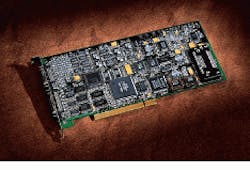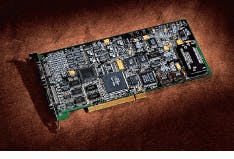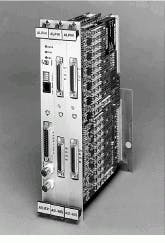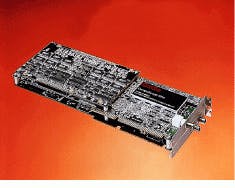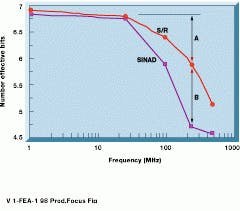OFF-THE-SHELF data-acquisition boards OFFER NUMEROUS CHOICES
OFF-THE-SHELF data-acquisition boards OFFER NUMEROUS CHOICES
By Andrew C. Wilson, Editor at Large
Machine-vision and imaging-system designers are confronted by hundreds of off-the-shelf data-acquisition boards from more than 50 vendors. Supplied in a range of form factors, these boards are available with a variety of specifications and software support. Not only must designers wrestle with diverse board types, but they must also carefully evaluate differing operating systems, throughput, scalability, and, perhaps most important, vendor support, to meet system needs.
For system designers to select a specific board, the data-acquisition requirements of the specific application must be fully understood. Sensor input, type of output, isolation needs, power requirements, physical dimensions, and acceptable performance should all be carefully investigated. Indeed, because overall system performance is only as good as the least accurate device in the system--typically the sensor--many vendors incorporate separate or integrated signal conditioners on their add-in boards. Such signal conditioners can compensate for signal differences in hardware or software and can be used to automatically calibrate systems for age and drift.
In many data-acquisition systems, however, sensors are not very accurate and do not require expensive signal-conditioned front ends. What is probably more important is the number of channels, the sampling rate, the resolution, and the input range and gain of the data-acquisition board.
According to Leslie Logan, data-acquisition product-marketing manager of Data Translation Inc. (Marlboro, MA), "Data-acquisition boards from reputable manufacturers are fully specified for their analog performance, but if all the specifications are not published, then buyer beware because the performance is probably not designed in or tested for."
Several important specifications must be analyzed before choosing a data-acquisition board. These include the number of channels, sampling rate, accuracy, input range, and gain. On a data-acquisition board, the number of channels determines how many signals can be captured; these are specified as single-ended, pseudodifferential, or differential inputs. Whereas single-ended channels have inputs referred to a common computer ground, psuedodifferential channels are all referred to a common ground not connected to the computer. Differential inputs, on the other hand, all have an independent reference for each channel, none of which are connected to computer ground. Here, too, the choice of channel type is application-dependent.
Chad Chesney, applications engineering group manager of data-acquisition products at National Instruments (Austin, TX), says, "As a general rule, you can use single-ended inputs when the input signals are larger than 1 V, the leads from the signal source to the board are shorter than 15 ft, and all inputs share a common reference."
Featuring 16 single-ended or eight differential inputs, the CIO-DAS1400 Series from Geotest (Irvine, CA) is typical of the data-acquisition boards available on the PC-XT/AT bus. Both the CIO-DAS1400/12 and /16 contain two on-board multiplexers that can be configured as 16 channels of single-ended input or eight channels of differential input. Acquired data are captured at 130 kHz (12 bits) or at 100 kHz (16 bits), transferred through an on-board first-in, first-out buffer, and stored until the personal computer (PC) can transfer the data to PC memory.
While many ISA-based data-acquisition products are still available, the advantages of the PCI bus have led to a proliferation of PCI-based data-acquisition products from several vendors including Data Translation, Intelligent Instrumentation (Tucson, AZ), and Markenrich (Duarte, CA). These boards leverage the 132-Mbyte/s burst rate of the PCI bus and furnish high-speed data-acquisition, plug-and-play autoconfiguration, and platform independence.
In Data Translation`s DT3000 Series (see Fig. 2 don`t have), the PCI-EZ board, for example, features simultaneous analog-to digital (A/D), digital-to-analog (D/A), and digital input/output (I/O) operation at full-rated throughput. To ensure performance, the boards use circular buffers to store multiple values for simultaneous transfer across the PCI bus. Current PCI-EZ boards offer 330-kHz A/D throughput from one channel, 64 analog inputs, and eight digital I/O lines.
Sampling rate important
Sampling rate is a key parameter when specifying a data-acquisition board. Because of the Nyquist criteria, system designers should choose a board that can sample at least twice as fast as the frequency of the signal to be acquired. On many boards capable of multichannel sampling, the maximum sampling rate may not be achievable with full accuracy because of the settling time of the instrumentation amplifier used on the board.
"Settling time provides a better measurement of the ac performance of the analog input subsystem than the accuracy specification," says Data Translation`s Logan. "If channels are switched before the input from the previous channel has settled to zero, a residual value will be added to the measurement of the next channel."
"A few years ago," says Rodger Hosking, vice president of Pentek (Upper Saddle River, NJ), "the limit for a relatively high-performance 10-MHz analog-to-digital converter suitable for mounting on a standard bus system board was 12-bits. Today, these boards feature 16-bit accuracy."
Possibly the fastest 16-bit add-in board is supplied by Gage Applied Sciences (Montreal, Quebec, Canada; see Fig. 2). As an add-in board for the ISA bus, the board is capable of sampling 16-bit data at 10-million-sample-per-second (MSPS) rates while maintaining an 85-dB spurious free dynamic range. Because the sampling rate of the board is much faster than the ISA bus can handle, data are stored on-board for later transfer.
Indeed, 16-bit accuracy is emerging as the de facto resolution standard, not only in PC- and PCI-based products, but also in the VME arena. Here, systems integrators can take advantage of the well-established VME standard to build high-performance data-acquisition systems. Already, a number of vendors, including Aitech Defense Systems (Santa Clara, CA), Alphi Technology (Tempe, AZ), and Echotek (Huntsville, AL), are fielding VME-based 16-bit boards.
Aitech`s offering, the C403, is a 68030-based VME-board that features one 12-bit A/D converter with a sample rate of up to 400 kS/s and one 16-bit converter with a sample rate of 100 kS/s. Each converter can be multiplexed to provide 16 differential or 32 single-ended channels. The on-board Motorola 68030 microprocessor is used to process incoming and outgoing data and transfer data between the global VMEbus or local memory and the VMEbus controller.
Like the C403, the ADM-96S-16 from Alphi also incorporates a 68030 processor (see Fig. 3). With up to 96 single-ended inputs, the board can digitize signals with 16-bit resolution at up to 100 KSPS. Featuring the VIC068/VAC068 VME interface chipset, the board is capable of supporting both master and slave DMA transfers.
In building high-performance data-acquisition systems, designers using VME boards must also consider the availability of high-speed board-to-board interconnects that tie multiple systems together. In this regard, Echotek offers a VME Raceway bridge for its FRADC series of VME-based data-acquisition products. Offering two channels of 16-bit, 2-MHz conversion, the board also provides on-board data buffering and interfaces to a deep off-board buffer memory.
Quantization error
Converting data from analog to digital introduces another source of error in data acquisition -- quantization error. This problem occurs because the analog signal is sampled, and its level is represented by a finite number of bits. "Quantization error defines a baseline noise level that limits the system`s ability to resolve small signals," comments Tony Girard, engineering manager of Signatec (Corona, CA), a manufacturer of ISA, PCI, and VME boards. "This is commonly referred to as the ratio of the rms of the largest signal divided by the rms value of the noise or the signal-to-noise ratio," he adds. Thus, higher-resolution systems will have a lower baseline noise, resulting in a greater dynamic range.
To determine the signal range that can be detected by the data-acquisition system, designers must know both the input range and the gain of the board. Because range and gain are normally specified separately, they must therefore be combined to determine the smallest detectable voltage. The signal input range is then determined by dividing the voltage range by the gain.
System performance
Nonlinearity, noise from reference voltages, sampling rate, and board design all determine the performance of data-acquisition systems. However, the frequency and the amplitude of the input signals have the greatest influence on the effective number of bits. Indeed, in most data-acquisition systems, the effective number of bits decreases significantly as the signal frequency increases. Consequently, system designers must understand how this relationship works.
"Often, data-acquisition-system manufacturers specify a performance parameter called SINAD, the ratio of the sinusoidal signal power (SIN) acquired to the total noise and distortion (NAD)," says Girard. Because this parameter contains noise and distortion, it can be used to compute the effective number of bits. "When the signal-to-noise ratio is specified, it is often the ratio of the sinusoidal power to the noise, not including the harmonics," he explains.
Two methods exist to compute the effective number of bits: time domain and frequency analysis. Signatec prefers the frequency-analysis method. When computed over the frequency range of the converter board, the difference between SINAD and signal-to-noise ratio can be dramatic (see Fig. 1). "The decrease in effective bits as the signal frequency increases," advises Girard, "is typical of high-speed, high-bandwidth systems." The decrease in effective bits from the signal-to-noise-ratio calculation is due to digitizer clock and aperture jitter. The difference in the decrease between the signal-to-noise ratio and the SINAD effective bits is due to signal distortion.
Making choices
Weighing technical specifications, bus choices, operating systems, and software support are challenging tasks for data-acquisition-system designers. Fortunately, making intelligent choices has been simplified by the widespread use of the Internet. In addition to providing product specifications, many board-vendor sites feature on-line tutorials, technical manuals, and application notes (see "Five top data-acquisition Web sites"). Before choosing a specific data-acquisition board, however, system designers should check out not only the board specifications, but also the product support services provided by the vendor. Often, vendor-supplied application notes and white papers can provide much of the information system designers need to develop a data-acquisition system.
FIGURE 1. As part of Data Translation`s DT3000 Series, the DT3010 is a PCI-based data-acquisition board with 12-bit resolution and a 1.25-MSPS sampling rate.
FIGURE 2. Gage Applied Sciences`s Compuscope is claimed to be the world`s fastest 16-bit A/D system capable of performing a 16-bit A/D conversion at real-time sampling rates up to 10 MSPS.
FIGURE 3. With up to 96 single-ended inputs, the ADM-96S-16 VME board from Alphi can digitize signals at up to 100 ksamples per channel with 16-bit accuracy.
FIGURE 4. As the sampling frequency of a data converter board increases, its effective number of bits decreases. Considering noise and distortion effects (SINAD) gives system designers a more realistic parameter than S/N ratio alone.
